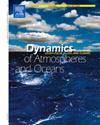On baroclinic instability of curved fronts
IF 2
4区 地球科学
Q2 GEOCHEMISTRY & GEOPHYSICS
引用次数: 0
Abstract
Baroclinic instability has traditionally been examined using a model of a straight front in approximate geostrophic and hydrostatic balance. However, mesoscale curved fronts and eddies are ubiquitous in the oceans and their curvature may have an impact on baroclinic instability. In this study, we present modifications of the classical Eady and Charney problems, introducing a small amount of curvature in the small-Rossby, large-Richardson number limit. Employing quasi-geostrophic scalings for a predominantly zonal flow in cylindrical polar coordinates, we derive the governing equation of perturbation pressure in the presence of small curvature, treating this quantity as a deviation from a straight front. We find the importance of curvature principally arises through the potential vorticity (PV) gradient. Consequently, although curvature enters the Eady model via an introduction of so-called Green modes, the introduction of curvature does not modify the most unstable mode. In Charney’s model, however, the curvature of the flow introduces a depth scale that governs the vertical extent of the unstable modes and whose importance often presides over planetary beta. We find that introducing cyclonic curvature in Charney’s model increases the horizontal wavelength of the most unstable mode. We also report that curvature modifies the vertical buoyancy flux by extending the vertical scale of the most unstable mode. The possible consequences of these results are discussed. Since our present-day understanding of baroclinic instability assumes centrifugal forces in the mean state to be zero and since this undergirds existing eddy parameterizations, this study (1) offers a new interpretation of at least some of the observed vortices in the ocean and (2) suggests a weakly-curved Charney model might inform future sub-grid-scale parameterizations of baroclinic instability of curved fronts in the oceans.

弯曲锋的斜压不稳定性
斜压不稳定性传统上是用近似地转和静水平衡中的直锋模型来检验的。然而,中尺度的弯曲锋和涡流在海洋中无处不在,它们的曲率可能对斜压不稳定有影响。在本研究中,我们提出了经典Eady和Charney问题的修正,在小罗斯比,大理查德森数极限中引入了少量的曲率。在柱面极坐标下,我们采用准地转标度法,推导了小曲率下扰动压力的控制方程,并将此量视为与直线锋面的偏差。我们发现曲率的重要性主要来自于位涡度(PV)梯度。因此,虽然曲率通过引入所谓的格林模态而进入Eady模型,但曲率的引入并没有改变最不稳定的模态。然而,在查尼的模型中,水流的曲率引入了一个深度标度,该深度标度控制着不稳定模式的垂直范围,其重要性往往高于行星的beta值。我们发现在Charney模型中引入气旋曲率增加了最不稳定模态的水平波长。我们还报道了曲率通过扩展最不稳定模态的垂直尺度来改变垂直浮力通量。讨论了这些结果可能产生的后果。由于我们目前对斜压不稳定性的理解假设离心力在平均状态下为零,并且由于这巩固了现有的涡参数化,因此本研究(1)对至少一些观测到的海洋涡旋提供了新的解释,(2)表明弱弯曲的Charney模式可能为未来海洋弯曲锋的斜压不稳定性的亚网格尺度参数化提供信息。
本文章由计算机程序翻译,如有差异,请以英文原文为准。
求助全文
约1分钟内获得全文
求助全文
来源期刊

Dynamics of Atmospheres and Oceans
地学-地球化学与地球物理
CiteScore
3.10
自引率
5.90%
发文量
43
审稿时长
>12 weeks
期刊介绍:
Dynamics of Atmospheres and Oceans is an international journal for research related to the dynamical and physical processes governing atmospheres, oceans and climate.
Authors are invited to submit articles, short contributions or scholarly reviews in the following areas:
•Dynamic meteorology
•Physical oceanography
•Geophysical fluid dynamics
•Climate variability and climate change
•Atmosphere-ocean-biosphere-cryosphere interactions
•Prediction and predictability
•Scale interactions
Papers of theoretical, computational, experimental and observational investigations are invited, particularly those that explore the fundamental nature - or bring together the interdisciplinary and multidisciplinary aspects - of dynamical and physical processes at all scales. Papers that explore air-sea interactions and the coupling between atmospheres, oceans, and other components of the climate system are particularly welcome.
 求助内容:
求助内容: 应助结果提醒方式:
应助结果提醒方式:


